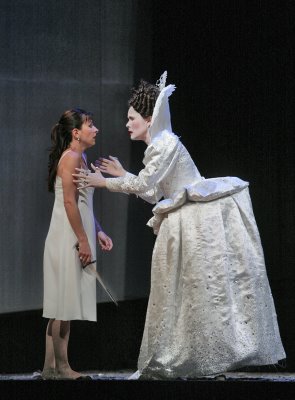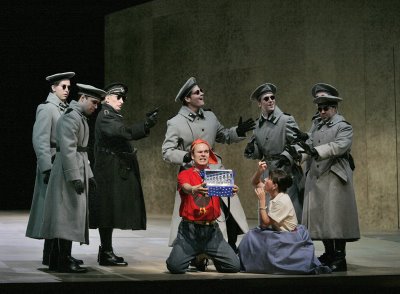Ionarts in Santa Fe: The Magic Flute
 Natalie Dessay as Pamina and Toby Spence as Tamino, 'Tamino mein', The Magic Flute, Santa Fe Opera, photo by Ken Howard © 2006 |
As for the rest of the cast, it was a very satisfying evening. Toby Spence was a dashing and vocally robust Tamino, even when he made his first entrance while supine in the mouth of a mechanical serpent. In Dies Bildnis, his tone was heroic but not overbearing, and his strong acting really gave the impression of the thunderbolt that hits him from seeing that picture of Pamina. Heather Buck's Queen of the Night was all icy venom, with impressive accuracy in her two infamous and stratospheric arias. There were a few issues of flexibility in the first act aria, and shifting from middle to high register sometimes involved a less than smooth difference in volume. As Papageno, Joshua Hopkins found a good combination of dolt and good heart. He is not to be blamed for the poor decision to have Papageno whistle instead of playing the little woodflute specifically indicated in the libretto ("In der Hand hat er eine kleine Waldflöte").
 Natalie Dessay as Pamina and Heather Buck as the Queen of the Night, The Magic Flute, Santa Fe Opera, photo by Ken Howard © 2006 |
Where this production failed, however, was in the prosaic and bizarre staging directed by Tim Albery, with sets and costumes by Tobias Hoheisel. The set was promising at the outset, with two walls of what looked like Frank Gehry's trademarked brushed titanium, matching the floor, opening to the famous vista of the Jeméz Mountains. It was a stark, almost monastic setting appropriate to Sarastro's temple, with colorful birds at the ends of poles. The mood was spoiled almost immediately as Papageno, during his first aria, "caught" his birds by plucking the stuffed creatures off their poles. I love challenging and even strange productions when they are guided by the score and libretto, but here the basic concept seemed to be to throw incongruent costumes on the singers and mix them together.
 David Cangelosi as Monostatos, Joshua Hopkins as Papageno, Natalie Dessay as Pamina, and Chorus, The Magic Flute, Santa Fe Opera, photo by Ken Howard © 2006 |
Other listeners were troubled by the English adaptation of the German dialogue, an option that makes perfect sense given the nature of the Singspiel as something for people to understand in their native language. I could have done without the little rhymed couplets, approaching doggerel, that concluded major scenes, and the incongruous collection of accents (Italian Sarastro, French Pamina, British Tamino, and so on) caused some laughter. What was lost in the glib English dialogue and the motley miscellany of the staging was the fairy tale beauty of Mozart's opera. The only thing that saved it was due to lighting designer Jennifer Tipton, who bathed the set in golden light whenever a didactic statement occurred in the libretto (found after the lock is put on Papageno's lips to keep him from lying, when the magic flute is described as bringing joy to the world, when the Glockenspiel makes Monostatos dance, when love is extolled in the second act). These moments of enlightenment, when Mozart and Schikaneder are trying to teach you something, were underscored by Ingmar Bergman's film version of the opera by the singers holding up the words on scrolls or signs. It was nice to know that someone on the Santa Fe production team had read the libretto.
Performances of The Magic Flute continue throughout August. Be aware that Susanna Phillips will replace Natalie Dessay in the role of Pamina on August 22 and 25.





















































3 comments:
"The three child singers who sang as the three boys were sometimes hard to hear but did a fine job for their age."
I suppose that, if they were not their age, they would also not be child singers, ey? :)
I became aware that Susanna Phillips would be singing Pamina in Santa Fe when a friend gmailed me that he was flying out from D. C. to hear her--and that musicians he knew all over the country (he's a wellregarded Anglocatholic Choirmaster)were doing the same.
Giacmc, to clarify: my final sentence here contains no tone of regret, only that Phillips would replace Dessay in the final two performances. There should be no chip on anyone's shoulder.
Post a Comment